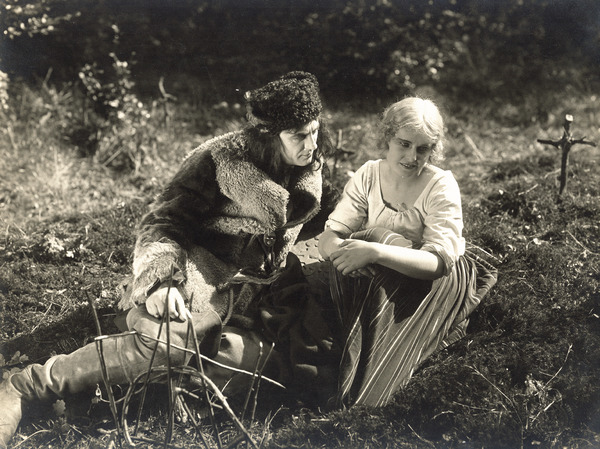LASSE MÅNSSON FRA SKAANE
(Struggling Hearts)
Anders Wilhelm Sandberg (DK 1923)
The story takes place during the Danish-Swedish war of 1657-1660. The narrow seas surrounding the Danish islands froze over in the harsh winter of 1657-58, and the Swedish King Karl X Gustav was able to march his armies across the ice to occupy most of the country. Plundering Swedish soldiers descend on the village of Gaabense on the island of Falster. Among them is Lasse Månsson, a Danish-born mercenary, feverish from a wound. Lasse is left in the village to recover; the Swedish king, whose life Lasse has saved during a battle, orders the tough and devious Corporal Printz to stay behind to ensure that the village is protected from further plundering. Recovering in the house of Ole Hassel, Lasse falls in love with his beautiful daughter Anne. He plans to desert the Swedish colors and start a new life with her, but the villainous Printz steals Lasse’s valuables, and Lasse leaves to find him. Months later, he tracks him down and confronts him. Now a fugitive, Lasse builds a hut in the forest. Anne joins him there, and the two experience a brief idyll together. Anne worries about her family, however, since the village has again been occupied by Swedish troops. She falls sick, and Lasse carries her home, even though he knows he risks capture and death.
The Swedish “Golden Age” cinema was, then and now, praised for the way it integrated the landscape into the drama, enriching characterization, atmosphere, and theme. Few Danish films attempted this, but there are elements of it in Lasse Månsson fra Skaane. The desolate, jagged ice-fields of the beginning are associated with the Swedish invaders, whose march across the frozen seas remained part of Danish cultural memory for a very long time. They form a striking contrast with the romantic idyll of the summer forest, warm sunlight filtering through the foliage to illuminate the happiness of Lasse and Anne. The tragic ending of the story reflects the outcome of the war, where Denmark lost the territory of Skåne (Scania), Lasse’s birthplace, which is now southern Sweden. In the orthography of the time, Danish used “aa” where Swedish would use “å” for the same sound; Danish adopted the Swedish letter “å” after World War II. The title’s juxtaposition of the names “Månsson” (spelled in the Swedish style) and “Skaane” (spelled in the Danish style) reflects the hero’s divided allegiance.
Nordisk’s main response to the Swedish challenge was, arguably, the four Dickens films, but Lasse Månsson fra Skaane is also part of the same effort to make prestigious quality pictures rather than mass-produced melodramas. The village where much of the action takes place was constructed as a full-scale set by production designer Carlo Jacobsen with the same meticulous attention to period detail found in the Dickens films. The film stars Poul Reumert; to silent-film fans, he is best known for playing Asta Nielsen’s circus-cowboy lover in Afgrunden (1910), but at the time he was cementing his reputation as perhaps the greatest Danish stage actor of his generation. The film is based on a well-regarded novel, although the author was unknown outside Denmark, even then. The cinematography is excellent; the forest scenes are gorgeous, and many of the interior scenes are wrapped in deep, carefully modulated shadows. One of the Danish reviewers praised the film’s images as “Luminous, clear, well-composed, with much of the Swedish film’s calm and harmony about them.”
The film was shot in 1920, but its release was held back. Nordisk had a considerable backlog of older films and often delayed premieres to avoid oversaturating the market; for instance, Dreyer’s Leaves from Satan’s Book, made in 1919, was not released in Denmark until 1921. Lasse Månsson fra Skaane was released in Sweden (to unenthusiastic reviews) ahead of its Danish premiere. While the Danish reviews were good, the film has remained largely unseen.
The DCP was scanned in May 2018 from an original nitrate print without titles; new title cards have been created based on the original intertitle list from the Danish Film Institute’s Nordisk collection.
Magnus Rosborn & Casper Tybjerg

regia/dir: Anders Wilhelm Sandberg.
scen: Valdemar Andersen; dal romanzo di/based on the novel by P. F. Rist (1903).
photog: Louis Larsen, Chresten Jørgensen, Einar Olsen.
scg/des: Carlo Jacobsen.
cast: Poul Reumert (Lasse Månsson), Frederik Jacobsen (Ole Hassel), Marie Dinesen (sua moglie/his wife), Olga d’Org (Anne, la figlia di Hassel/Hassel’s daughter), Martin Herzberg (Lille Helle, il fratello più giovane di Anne/Anne’s younger brother), Emil Helsengreen (il maniscalco/the blacksmith), Peter Nielsen (caporale/Corporal Printz), Charles Wilken (il vicario/Reverend Niels, the vicar).
prod: Nordisk Films Kompagni.
uscita/rel: 02.1923 (Uppsala), 05.04.1923 (København).
copia/copy: DCP (da/from 35mm), 79′; did./titles: DAN/ENG.
fonte/source: Det Danske Filminstitut, København.


 Italiano
Italiano